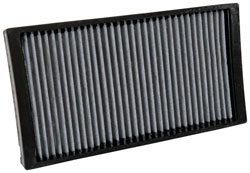2003 to 2011 BMW M-Series Benefits from a Cleanable, Reusable Cabin Air Filter from K&N
- 12 Aug 2016
BMW offers all kinds of models under its number series like the five and six series and its letter series like the M. The M (for Motorsport) series cars were initially introduced to support BMW's successful racing program of the 1960s and 1970s. However, the moniker soon became to be used to help fill out the company's stable of vehicles. These models are the modified higher trim models. These cars include modified engines, transmissions, suspensions, interior trims, aerodynamics and exterior changes that helped to set them apart from their colleagues. The first of the M series cars to be offered was the M1, which was a sports car unveiled in 1978 and sold through 1981. Today the M-Series stable includes the M2, a coupe introduced in 2015; the M3, a sedan unveiled in 2014; the M4, a coupe and cabriolet introduced in 2014; the M5, a sedan released in 2012; the M6, a cabriolet and coupe that was first offered in 2012 and a Gran Coupe that came out in 2013. Nineteen different engines have been used to power M-Series cars. From 2004-2010, a 5.0-liter V10 engine that generated 507 PS powered the M5 4-door sedan and station wagon. From 2005-2010, a 5.0-liter V10 engine that delivers 507 PS powered the M6 coupe and convertible. The second-generation 6 series including the 630i, 645CI, 635D, and 650i was introduced in 2003. A 3.0-liter straight 6 engine with valvetronic and dual yanos technology powered the 630Ci and 630i. A 3.0-liter diesel straight 6 engine with twin-turbocharger powered the 635d. BMW claimed that this was the first diesel Gran Tourer when it was released. This model offered more power, torque and fuel economy than the 630i. A 4.4-liter V8 that produced 329-horsepower and 330 lb-ft of torque powered the 645Ci. Production of the car was stopped in 2005 and the 650i, a bigger and quicker car, replaced it in 2006. A 4.8-liter V8 engine that delivered 360-horsepower and 360 lb-ft of torque powered the 650i. BMW introduced the 5 series in 1972. Initially, the car came in only a sedan body style. The touring body style was added in 1991 and the 5-door hatchback (known as the Gran Touring) was added in 2009. The 5 is BMW's second best-selling series after the 3-series and in 2010 accounted for about half of BMW's profits. On January 29, 2008, the 5 millionth 5-series was manufactured, a 530d sedan. The 5-series includes the BMW 528, 528i, 525i, 520i, the 530i, and the 535i. The fifth generation of the series started in 2004 and ran through 2010. This particular 5-series featured a longer and wider chassis than the previous generation and included iDrive, Active Roll Stabilization, Active Cruise Control, Park Distance Control and a Harman Kardon Logic7 sound system. The 4.4-liter V8 that powered this generation delivered 325-horsepower and was mated to a 6-speed manual or automatic transmission or newly created 6-speed Sequential Manual Gearbox that featured steering wheel-mounted shift paddles. The 5-series is currently in its sixth generation. These models are greater in length than the previous generations, permitting more rear legroom. These models are also the first BMWs to feature the new ZF eight-speed automatic transmission and a new brake energy regeneration system. Alpina Burkard Bovensiepen GmbH is a German automobile manufacturer who works with BMW in the design and manufacturing of the Alpina. Recognized as an automobile manufacturer, the company is actually more of an aftermarket tuner. The company enhances BMW cars and releases the results as an Alpina. Anyone who owns the "Ultimate Driving Machine" is going to want to be sure that its passenger cabin smells fresh and is healthy to occupy. K&N offers the VF4000 cabin air filter for this purpose. Designed and manufactured to freshen and clean incoming air into the car's cabin, the filter captures most molds, mildew, fungus, spores, bacteria, germs, pollen and allergens. The filter is electrostatically charged so that it can capture and hold impurities until it is cleaned. K&N recommends this be done every 12 months or 12,000 miles, depending on driving conditions. It is also designed to fit the factory cabin air filter box and is pre-treated and ready to install straight out of the box. K&N offers a cabin air filter cleaning kit that includes a substance that cleans out the impurities as well as a substance that recharges the electrostatic properties of the cabin air filter so that it can be used over and over again. Installation of the cabin air filter is simple. Simply remove the old filter from the factory box that is located in one of three locations –- under the hood, near the windshield; underneath the dashboard; or behind the glove box. Once the old filter has been removed, simply drop the new K&N filter into the box. Most cabin air filters can be replaced without tools. However, you may need basic hand tools to open the cover of the cabin air filter compartment. K&N is so sure that the cabin air filter will perform as promised it covers it with a 10-Year/Million Mile Limited Warranty. The K&N VF4000 cabin air filter fits the following vehicles: 2011 BMW M6 5.0L V10 Use the K&N Search by Vehicle Tool to find the proper K&N cabin air filter for your car, truck, or SUV. K&N is always creating new cabin air filters. If you can't find a filter for your particular vehicle, please ask us to make one for you using the online product request form. |
|||
|
|||










